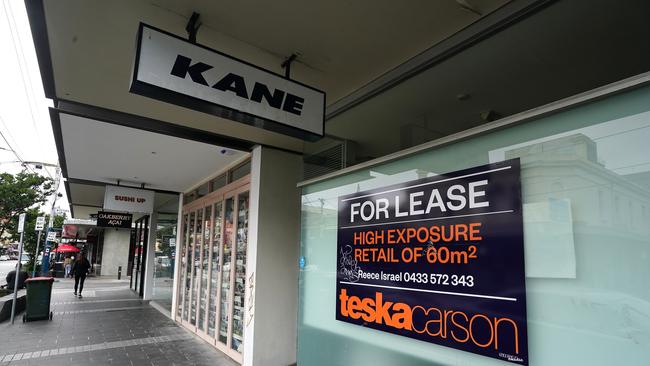Business insolvencies, loan failures loom and the pain is likely to intensify
Australia’s economy is teetering, business failures are increasing, confidence is slumping and loan failures loom, market watchers say.

A flood of company failures and a spike in bad loans are on the horizon according to market watchers, as consumer and business sentiment deteriorate.
CreditorWatch has warned a large increase in business failures is likely in 2024 as a string of interest rate rises, sticky inflation and a pullback in consumer spending take their toll.
The credit bureau said many businesses trading at a loss would not survive the coming six to nine months of high interest rates and low consumer confidence.
Ratings agency Fitch has warned that lending markets are deteriorating, with arrears exceeding pre-Covid levels.
National Australia Bank is also charting a worsening of trading conditions, with its latest business confidence survey revealing another quarter of weakening growth.
CreditorWatch said its Business Risk Index was indicating the insolvency rate would increase from 4.18 per cent up to 5.8 per cent by the middle of 2024, above pre-pandemic levels.
Business failure rates fell during the pandemic, as government support and tax relief sheltered many at-risk firms.
However, the removal of support payments and the Australian Taxation Office’s return to making tax default demands has seen insolvencies soar.
Defaults on business-to-business trade payments have increased 57 per cent since January.
CreditorWatch chief executive Patrick Coghlan said the increase was a forward indicator of looming business failures, with the decline in access to finance as lenders pulled back from the market set to worsen the collapse.
“It is tough and getting tougher, and will remain tough for the foreseeable future, with small businesses going to have a difficult period ahead over the next 12 months,” he told The Australian. “Come February and March we will get a clearer picture on just how many businesses will survive because December and January is when a lot of retailers and hospitality groups make their money, and if that doesn’t come through then many will have to pull the pin.”

CreditorWatch data showed invoice values were also slumping, down 34 per cent in the 12 months to November to circa $160,000 in what the company said was a sign of a sharp decline in activity on the back of weaker demand.
The latest figures from the corporate regulator showed 907 companies entered insolvency in November, almost double the level recorded a year prior and well above long term averages.
The data showed insolvencies were already tracking well above levels recorded in the 2023 financial year.
CreditorWatch said food and beverage services businesses were most at risk of default, followed by transport, postal and warehousing.
Mr Coghlan said that while the current rate of insolvencies was returning to pre-pandemic levels, business defaults were likely to peak at as much as 30 per cent above those levels.
“As we approach the end of the financial year we will have more clarity for the future. Times might still be tough, but there will be an understanding of when the first rate cut will be or when inflation will return to 2-3 per cent,” he said.
NAB’s latest business confidence figures reveal trading conditions and profitability have sagged in the latest quarter.
The bank’s figures found lending indicators had softened in the period, with forward orders down 3 points to minus 4 index points, with construction and recreation leading the slide.
NAB chief economist Alan Oster said confidence and conditions were now sliding “after a period of relative stability through mid-2023”.
“Outside of the pandemic period, business confidence is now its weakest since around 2012, when conditions were significantly weaker and growth in advanced economies was slowing,” he said.
“This month’s outcome suggests that growth in Q4 is unlikely to improve from the weak outcome in the Q3 national accounts, and while slower growth will eventually see an easing in inflation pressure, this will lag activity.”
Fitch also warned the lending market was deteriorating, with arrears in some segments now above pre-pandemic levels.

The agency said Australian residential mortgage-backed securities, or packages of home loans sold to investors by lenders, were showing higher arrears as more borrowers fell behind on payments.
Fitch senior director Natasha Vojvodic said ratings “should be supported by growing credit enhancement, which is likely to grow faster than any credit deterioration, coupled with excess spread and adequate liquidity”.
The agency said it expected 30 day arrears to peak at 1.3 per cent of all loans, while loans 90 days past due were expected to hit 0.65 per cent by the end of 2024, an increase of almost 10 basis points from the end of 2023.
Fitch said car lending was also likely to deteriorate, with loan defaults increasing through the first half of 2024.
But Fitch said the deterioration in these loans was “likely to be mild” and would peak in mid-2024 before moderating “on sustained low employment, disinflation and potential rate cuts”.
The ratings agency said defaults and arrears were set to rise on the back of unemployment and a high cash rate.
Fitch said it expected unemployment to lift to 4.2 per cent in 2024, up from 3.7 per cent recorded in October.
The agency said vulnerable borrowers, with high debt to income ratios or who were self employed with irregular income, were particularly exposed to the worsening environment.
Fitch said if property prices slumped this would affect loan performance, with borrowers underwater on debt unable to sell and exit.


